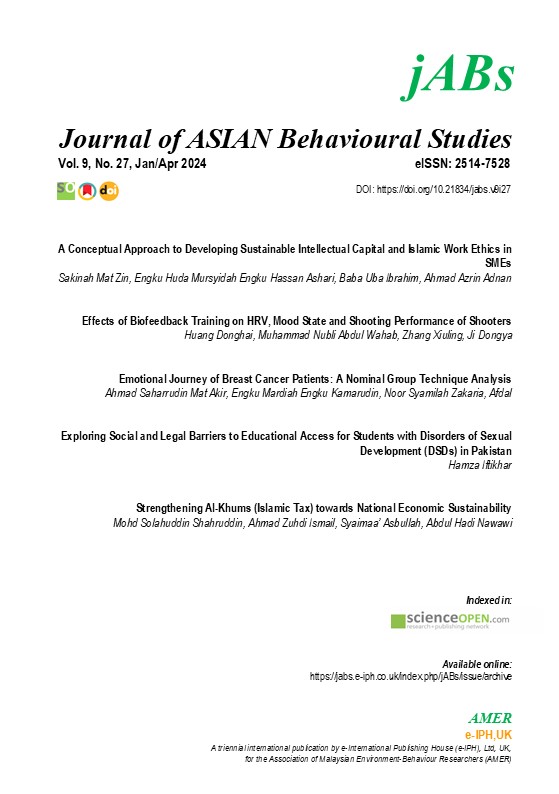Effects of Biofeedback Training on HRV, Mood State and Shooting Performance of Shooters
Main Article Content
Abstract
This study examines how biofeedback training affects athletes' HRV, emotional states, and shooting performance. Findings reveal substantial improvements in HRV indices (p < 0.05) and reductions in negative emotions such as tension and anger (p < 0.05). There were increases in vitality and positivity, although changes in fatigue and self-emotional state were not statistically significant (p > 0.05). Shooting performance showed significant enhancement following the training (p < 0.01). These results indicate that biofeedback training positively influences autonomic nervous system function, emotional stability, and shooting performance. By enhancing HRV, improving mood states, biofeedback training markedly improves shooting performance.
Article Details
License
Copyright (c) 2024 Huang Donghai , Muhammad Nubli Abdul Wahab , Zhang Xiuling , Ji Dongya

This work is licensed under a Creative Commons Attribution-NonCommercial-NoDerivatives 4.0 International License.
References
Argilés, M., Quevedo-Junyent, L., & Erickson, G. (2022). Topical review: optometric considerations in sports versus E-sports. Perceptual and motor skills,129(3), 731-746.
Baker, F., Denniston, M., Zabora, J., Polland, A., & Dudley, W. N. (2002). A POMS short form for cancer patients: psychometric and structural evaluation. Psycho‐Oncology: Journal of the Psychological, Social and Behavioral Dimensions of Cancer, 11(4), 273-281.
Cerritelli, F., Frasch, M. G., Antonelli, M. C., Viglione, C., Vecchi, S., Chiera, M., & Manzotti, A. (2021). A review on the vagus nerve and autonomic nervous system during fetal development: searching for critical windows. Frontiers in Neuroscience, 15, 721605.
Dagnall, N., Drinkwater, K. G., Denovan, A., & Walsh, R. S. (2021). The potential benefits of non-skills training (mental toughness) for elite athletes: Coping with the negative psychological effects of the COVID-19 pandemic. Frontiers in Sports and Active Living, 3, 581431.
Englert, C., Dziuba, A., Wolff, W., & Giboin, L. S. (2021). An investigation of the effects of self-reported self-control strength on shooting performance. Psychology of Sport and Exercise, 52, 101839.
Gronwald, T., Hoos, O., & Hottenrott, K. (2020). Influence of performance level of male runners on non-linear dynamics of heart rate variability during a 10Km race. International Journal of Performance Analysis in Sport, 20(4), 569-583.
Horvath, E., Kovacs, M. T., Toth, D., & Toth, L. (2022). A study of the relationship between anxiety, cognitive emotion regulation and heart rate variability in athletes. Journal of physical education and sport,22(2), 528-534.
Ju, F., Wang, Y., Yin, B., Zhao, M., Zhang, Y., Gong, Y., & Jiao, C. (2023). Microfluidic wearable devices for sports applications. Micromachines, 14(9), 1792.
Lehrer, P., Kaur, K., Sharma, A., Shah, K., Huseby, R., Bhavsar, J., & Zhang, Y. (2020). Heart rate variability biofeedback improves emotional and physical health and performance: A systematic review and meta-analysis. Applied psychophysiology and biofeedback,45, 109-129.
Ortega, E., & Wang, C. J. K. (2018). Pre-performance physiological state: Heart rate variability as a predictor of shooting performance. Applied psychophysiology and biofeedback,43, 75-85.
Park, S. H., Jeon, J. Y., & Lim, S. T. (2020). The relationship between psychological and physiological stress perceived by elite shooters. Korean Journal of Sport Science,31(2), 370-381.
Pizzoli, S. F., Marzorati, C., Gatti, D., Monzani, D., Mazzocco, K., & Pravettoni, G. (2021). A meta-analysis on heart rate variability biofeedback and depressive symptoms. Scientific reports, 11(1), 6650.
Ramchandani, R., Florica, I. T., Zhou, Z., Alemi, A., & Baranchuk, A. (2024). Review of Athletic Guidelines for High-Altitude Training and Acclimatization. High Altitude Medicine & Biology, 25(2), 113-121.
Rydzik, Ł., Wąsacz, W., Ambroży, T., Javdaneh, N., Brydak, K., & Kopańska, M. (2023). The Use of Neurofeedback in sports Training: systematic review. Brain Sciences,13(4), 660.
Spangler, D. P., Alam, S., Rahman, S., Crone, J., Robucci, R., Banerjee, N., ... & Brooks, J. R. (2020). Multilevel longitudinal analysis of shooting performance as a function of stress and cardiovascular responses. IEEE Transactions on Affective Computing, 12(3), 648-665.
Sut Txi, M. R., Hashim, H. A., & Krasilshchikov, O. (2020). The Effects of Integrating Biofeedback Training into a 12-Week Periodized Training Program on Galvanic Skin Response and Anxiety Level Among Junior Archers. In Enhancing Health and Sports Performance by Design: Proceedings of the 2019 Movement, Health & Exercise (MoHE) and International Sports Science Conference (ISSC) (pp. 528-537). Springer Singapore.
Tok, S., Dal, N., Zekioğlu, A., Çatıkkaş, F., Balıkçı, İ., & Doğan, E. (2020). Autonomic cardiac activity among novice archers during baseline, shooting, and recovery. The Journal of Strength & Conditioning Research, 34(9), 2627-2635.
Wang, H., Wang, W., Wu, D., Gao, X., & Shi, Y. (2024). The mechanism and application of heart rate variability biofeedback regulation of the autonomic nervous system. Chinese Journal of Tissue Engineering Research,28(26), 4257.
Lagos, L., Vaschillo, E., Vaschillo, B., Lehrer, P., Bates, M., & Pandina, R. (2008). Heart rate variability biofeedback as a strategy for dealing with competitive anxiety: A case study. Biofeedback, 36(3), 109.
Paul, M., Garg, K., & Sandhu, J. S. (2012). Role of biofeedback in optimizing psychomotor performance in sports. Asian journal of sports medicine, 3(1), 29.
